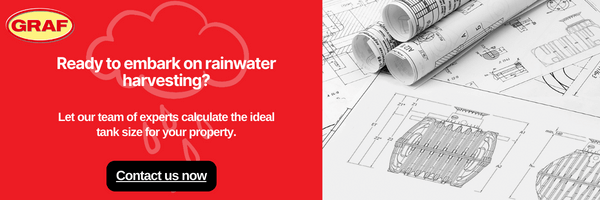If you are considering buying a rainwater harvesting tank you will have to figure out what size you will need. To ensure you make the right purchase we explain how to size a rainwater harvesting tank below.
General sizing
In general terms, the following sizes are usually a good guide for use in domestic environments:
- 1,500 to 3,000 litres: Suitable for 1-4 people doing small amounts of garden irrigation
- 3,000 to 5,000 litres: Suitable for 4-6 people doing occasional amounts of garden irrigation
- 5,000 to 7,000 litres: Suitable for 4 or more people doing regular amounts of garden irrigation
There are a number of factors that need to be considered when buying a rainwater harvesting tank and the following sections may help you make a more informed decision based on your individual requirements.
Rainfall amount
Rainfall differs depending on where you live in the UK. For example, based on 34 years of data collected by the Met Office between 1981 and 2015:
- Cardiff: 1,152mm of rain (149 rainy days per year)
- Glasgow: 1,138mm (151 days)
- Manchester: 867mm (152 days)
- Sunderland: 597mm (110 days)
- London: 557mm (109 days)
The heavier the rainfall in your area, the more you will be able to harvest. Taking into account the other factors discussed in this article, this will help you determine how large you need the tank to be.
Roof size
The larger the roof of your home is, the more rain will be collected and stored by the harvesting tank. If you don’t know the dimensions of your roof and feel unsafe going up to measure, you can get a rough estimate from the ground level.
This can be done by measuring the width and length of your home and multiplying these together. Of course, this doesn’t take into account the roof pitch (slope_ but it should be accurate enough to help you decide on the size of tank you need.
Water usage
The calculations at the start of the article were largely based on watering the garden only. However, harvested rainwater can be used for much more, including washing the car, flushing the toilet and other chores.
Everyone has different water usage levels but using average figures can help. For example, based on using a modern dual-flush toilet (5 litres per flush) with an average of 5 flushes per day, and 2 wash-loads per week (around 80 litres in total), one person’s water usage for these activities would be 255 litres each week.
If you then add on an estimated 35 litres of water per person each week for water usage outside, this creates an estimated total of 290 litres for each individual. Multiply this figure by the number of people living in the house to get a total weekly average of the water usage and multiply this number again by 52 weeks to get an annual estimate.
Drought protection levels
In the event of a hosepipe ban due to a long, hot and dry summer, you may need to solely rely on the stored water in your tank. Of course, there is no way of knowing how long the gaps will be in-between rainfall, so it makes sense to have around 2-3 week’s worth of water stored to cover you during this period.



